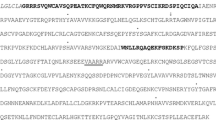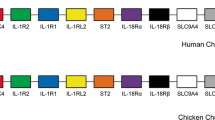Abstract
Activated mast cells release a number of potent inflammatory mediators including histamine, proteoglycans, cytokines, and serine proteases. The proteases constitute the majority of the mast cell granule proteins, and they belong to either the chymase or the tryptase family. In mammals, these enzymes are encoded by two different loci, the mast cell chymase and the multigene tryptase loci. In mice and humans, a relatively large number of tryptic enzymes are encoded from the latter locus. These enzymes can be grouped into two subfamilies, the group 1 tryptases, with primarily membrane-anchored enzymes, and the group 2 tryptases, consisting of the soluble mast cell tryptases. In order to study the appearance of these enzymes during vertebrate evolution, we have analyzed the dog, cattle, opossum, and platypus genomes and sought orthologues in the genomes of several bird, frog, and fish species as well. Our results show that the overall structure and the number of genes within this locus have been well conserved from marsupial to placental mammals. In addition, two relatively distantly related group 2 tryptase genes and several direct homologues of some of the group 1 genes are present in the genome of the platypus, a monotreme. However, no direct homologues of the individual genes of either group 1 or 2 enzymes were identified in bird, amphibian, or fish genomes. Our results indicate that the individual genes within the multigene tryptase locus, in their present form, are essentially mammal-specific.




Similar content being viewed by others
Abbreviations
- aa:
-
Amino acid
- mMCP:
-
Mouse mast cell protease
- nt:
-
Nucleotide
- Sim.:
-
Similar to
- corr:
-
Corrected
- SP:
-
Serine protease
- hypo. pr.:
-
Hypothetical protein
References
Bhagwandin VJ, Hau LW, Mallen-St Clair J, Wolters PJ, Caughey GH (2003) Structure and activity of human pancreasin, a novel tryptic serine peptidase expressed primarily by the pancreas. J Biol Chem 278:3363–3371
Caughey GH (2004) Genetic insights into mast cell chymase and tryptase function. Clin Exp All Rev 4:96–101
Caughey GH, Raymond WW, Blount JL, Hau LW, Pallaoro M, Wolters PJ, Verghese GM (2000) Characterization of human gamma-tryptases, novel members of the chromosome 16p mast cell tryptase and prostasin gene families. J Immunol 164:6566–6575
Daniels RJ, Peden JF, Lloyd C, Horsley SW, Clark K, Tufarelli C, Kearney L, Buckle VJ, Doggett NA, Flint J, Higgs DR (2001) Sequence, structure and pathology of the fully annotated terminal 2 Mb of the short arm of human chromosome 16. Hum Mol Genet 10:339–352
Echtenacher B, Mannel DN, Hultner L (1996) Critical protective role of mast cells in a model of acute septic peritonitis. Nature 381:75–77
Fajardo I, Pejler G (2003) Formation of active monomers from tetrameric human beta-tryptase. Biochem J 369:603–610
Gallwitz M, Hellman L (2006) Rapid lineage-specific diversification of the mast cell chymase locus during mammalian evolution. Immunogenetics 58:641–654
Gallwitz M, Reimer JM, Hellman L (2006) Expansion of the mast cell chymase locus over the past 200 million years of mammalian evolution. Immunogenetics 58:655–669
Gallwitz M, Enoksson M, Hellman L (2007) Expression profile of novel members of the rat mast cell protease (rMCP)-2 and (rMCP)-8 families, and functional analyses of mouse mast cell protease (mMCP)-8. Immunogenetics 59:391–405
Hallgren J, Karlson U, Poorafshar M, Hellman L, Pejler G (2000) Mechanism for activation of mouse mast cell tryptase: dependence on heparin and acidic pH for formation of active tetramers of mouse mast cell protease 6. Biochemistry 39:13068–13077
Hallgren J, Spillmann D, Pejler G (2001) Structural requirements and mechanism for heparin-induced activation of a recombinant mouse mast cell tryptase, mouse mast cell protease-6: formation of active tryptase monomers in the presence of low molecular weight heparin. J Biol Chem 276:42774–42781
Hallgren J, Backstrom S, Estrada S, Thuveson M, Pejler G (2004) Histidines are critical for heparin-dependent activation of mast cell tryptase. J Immunol 173:1868–1875
Hooper JD, Nicol DL, Dickinson JL, Eyre HJ, Scarman AL, Normyle JF, Stuttgen MA, Douglas ML, Loveland KA, Sutherland GR, Antalis TM (1999) Testisin, a new human serine proteinase expressed by premeiotic testicular germ cells and lost in testicular germ cell tumors. Cancer Res 59:3199–3205
Hooper JD, Bowen N, Marshall H, Cullen LM, Sood R, Daniels R, Stuttgen MA, Normyle JF, Higgs DR, Kastner DL, Ogbourne SM, Pera MF, Jazwinska EC, Antalis TM (2000) Localization, expression and genomic structure of the gene encoding the human serine protease testisin. Biochim Biophys Acta 1492:63–71
Huang C, Li L, Krilis SA, Chanasyk K, Tang Y, Li Z, Hunt JE, Stevens RL (1999) Human tryptases alpha and beta/II are functionally distinct due, in part, to a single amino acid difference in one of the surface loops that forms the substrate-binding cleft. J Biol Chem 274:19670–19676
Inoue M, Isobe M, Itoyama T, Kido H (1999) Structural analysis of esp-1 gene (PRSS 21). Biochem Biophys Res Commun 266:564–568
Knight PA, Wright SH, Lawrence CE, Paterson YY, Miller HR (2000) Delayed expulsion of the nematode Trichinella spiralis in mice lacking the mucosal mast cell-specific granule chymase, mouse mast cell protease-1. J Exp Med 192:1849–1856
O’Sullivan CM, Liu SY, Rancourt SL, Rancourt DE (2001a) Regulation of the strypsin-related proteinase ISP2 by progesterone in endometrial gland epithelium during implantation in mice. Reproduction 122:235–244
O’Sullivan CM, Rancourt SL, Liu SY, Rancourt DE (2001b) A novel murine tryptase involved in blastocyst hatching and outgrowth. Reproduction 122:61–71
Pallaoro M, Gambacurta A, Fiorucci L, Mignogna G, Barra D, Ascoli F (1996) cDNA cloning and primary structure of tryptase from bovine mast cells, and evidence for the expression of bovine pancreatic trypsin inhibitor mRNA in the same cells. Eur J Biochem 237:100–105
Pallaoro M, Fejzo MS, Shayesteh L, Blount JL, Caughey GH (1999) Characterization of genes encoding known and novel human mast cell tryptases on chromosome 16p13.3. J Biol Chem 274:3355–3362
Pereira PJ, Bergner A, Macedo-Ribeiro S, Huber R, Matschiner G, Fritz H, Sommerhoff CP, Bode W (1998) Human beta-tryptase is a ring-like tetramer with active sites facing a central pore. Nature 392:306–311
Raymond WW, Sommerhoff CP, Caughey GH (2005) Mastin is a gelatinolytic mast cell peptidase resembling a mini-proteasome. Arch Biochem Biophys 435:311–322
Sakai K, Ren S, Schwartz LB (1996) A novel heparin-dependent processing pathway for human tryptase. Autocatalysis followed by activation with dipeptidyl peptidase I. J Clin Invest 97:988–995
Sato M, Yoshida S, Iida K, Tomozawa T, Kido H, Yamashita M (2003) A novel influenza A virus activating enzyme from porcine lung: purification and characterization. Biol Chem 384:219–227
Shaw-Smith CJ, Coffey AJ, Leversha M, Freeman TC, Bentley DR, Walters JR (2000) Characterisation of a novel murine intestinal serine protease. DISP. Biochim Biophys Acta 1490:131–136
Tang L, Rancourt DE (2005) Murine implantation serine proteinases 1 and 2: structure, function and evolution. Gene 364:30–36
Thompson JD, Gibson TJ, Plewniak F, Jeanmougin F, Higgins DG (1997) The CLUSTAL_X windows interface: flexible strategies for multiple sequence alignment aided by quality analysis tools. Nucleic Acids Res 25:4876–4882
Trivedi NN, Tong Q, Raman K, Bhagwandin VJ, Caughey GH (2007) Mast cell alpha and beta tryptases changed rapidly during primate speciation and evolved from gamma-like transmembrane peptidases in ancestral vertebrates. J Immunol 179:6072–6079
Trivedi NN, Raymond WW, Caughey GH (2008) Chimerism, point mutation, and truncation dramatically transformed mast cell delta tryptases during primate evolution. J Allergy Clin Immunol 121:1262–1268
Vanderslice P, Craik CS, Nadel JA, Caughey GH (1989) Molecular cloning of dog mast cell tryptase and a related protease: structural evidence of a unique mode of serine protease activation. Biochemistry 28:4148–4155
Vernersson M, Ledin A, Johansson J, Hellman L (2002) Generation of therapeutic antibody responses against IgE through vaccination. Faseb J 16:875–877
Vernersson M, Aveskogh M, Hellman L (2004) Cloning of IgE from the echidna (Tachyglossus aculeatus) and a comparative analysis of epsilon chains from all three extant mammalian lineages. Dev Comp Immunol 28:61–75
Wang HW, McNeil HP, Husain A, Liu K, Tedla N, Thomas PS, Raftery M, King GC, Cai ZY, Hunt JE (2002) Delta tryptase is expressed in multiple human tissues, and a recombinant form has proteolytic activity. J Immunol 169:5145–5152
Wernersson S, Reimer JM, Poorafshar M, Karlson U, Wermenstam N, Bengten E, Wilson M, Pilstrom L, Hellman L (2006) Granzyme-like sequences in bony fish shed light on the emergence of hematopoietic serine proteases during vertebrate evolution. Dev Comp Immunol 30:901–918
Wong GW, Tang Y, Feyfant E, Sali A, Li L, Li Y, Huang C, Friend DS, Krilis SA, Stevens RL (1999) Identification of a new member of the tryptase family of mouse and human mast cell proteases which possesses a novel COOH-terminal hydrophobic extension. J Biol Chem 274:30784–30793
Wong GW, Yasuda S, Madhusudhan MS, Li L, Yang Y, Krilis SA, Sali A, Stevens RL (2001) Human tryptase epsilon (PRSS22), a new member of the chromosome 16p13.3 family of human serine proteases expressed in airway epithelial cells. J Biol Chem 276:49169–49182
Wong GW, Yasuda S, Morokawa N, Li L, Stevens RL (2004) Mouse chromosome 17A3.3 contains 13 genes that encode functional tryptic-like serine proteases with distinct tissue and cell expression patterns. J Biol Chem 279:2438–2452
Yezzi MJ, Hsieh IE, Caughey GH (1994) Mast cell and neutrophil expression of dog mast cell protease-3. A novel tryptase-related serine protease. J Immunol 152:3064–3072
Acknowledgments
This investigation was supported by grants from the Swedish Natural Sciences Research Council (VR-NT) and grant RR-014214 from the US National Institutes of Health (PBS). We would also like to thank Michael Thorpe for linguistic revision and valuable comments on the manuscript.
Author information
Authors and Affiliations
Corresponding author
Rights and permissions
About this article
Cite this article
Reimer, J.M., Samollow, P.B. & Hellman, L. High degree of conservation of the multigene tryptase locus over the past 150–200 million years of mammalian evolution. Immunogenetics 62, 369–382 (2010). https://doi.org/10.1007/s00251-010-0443-2
Received:
Accepted:
Published:
Issue Date:
DOI: https://doi.org/10.1007/s00251-010-0443-2




